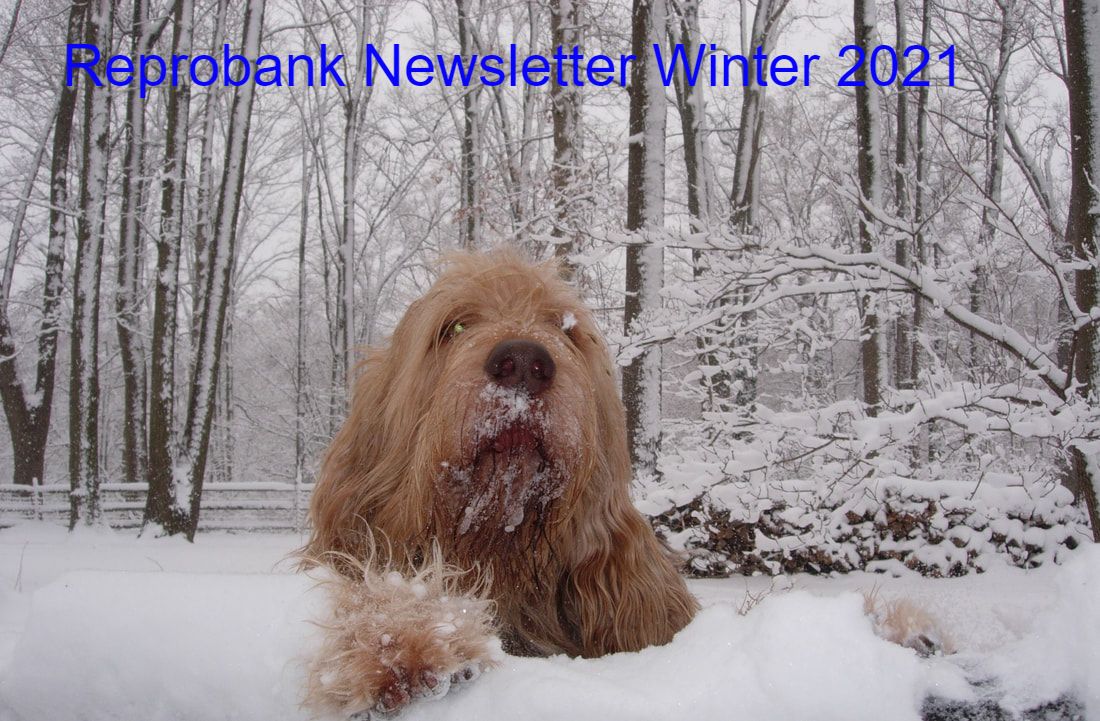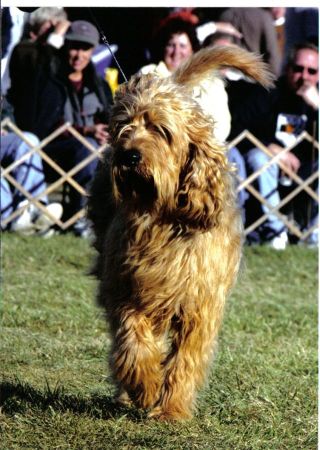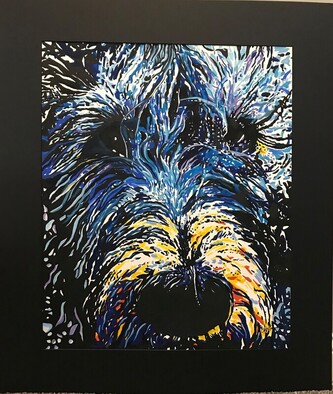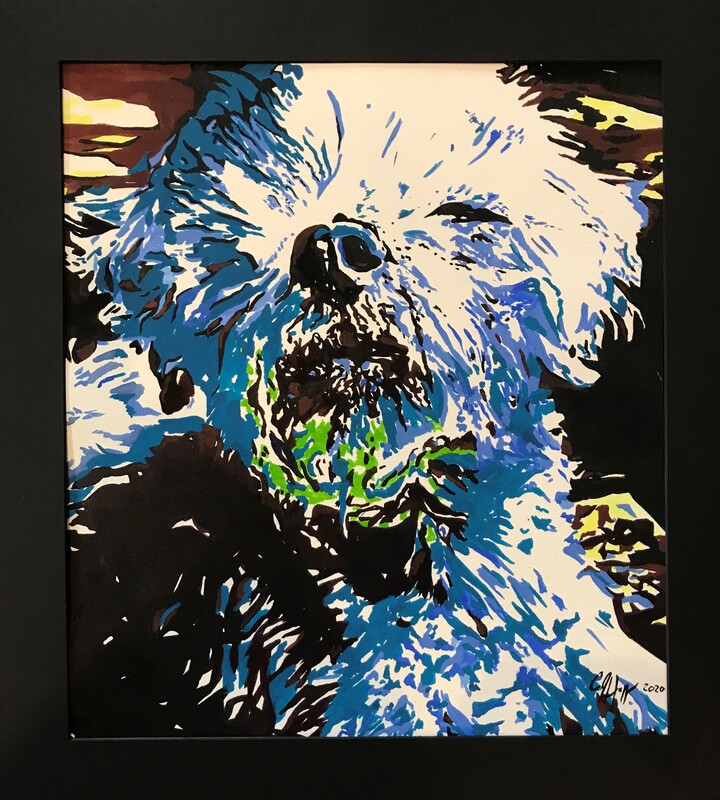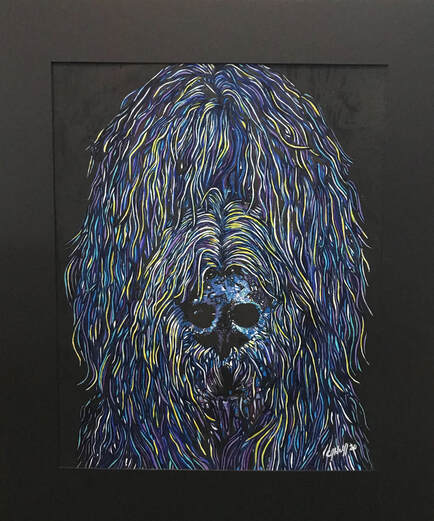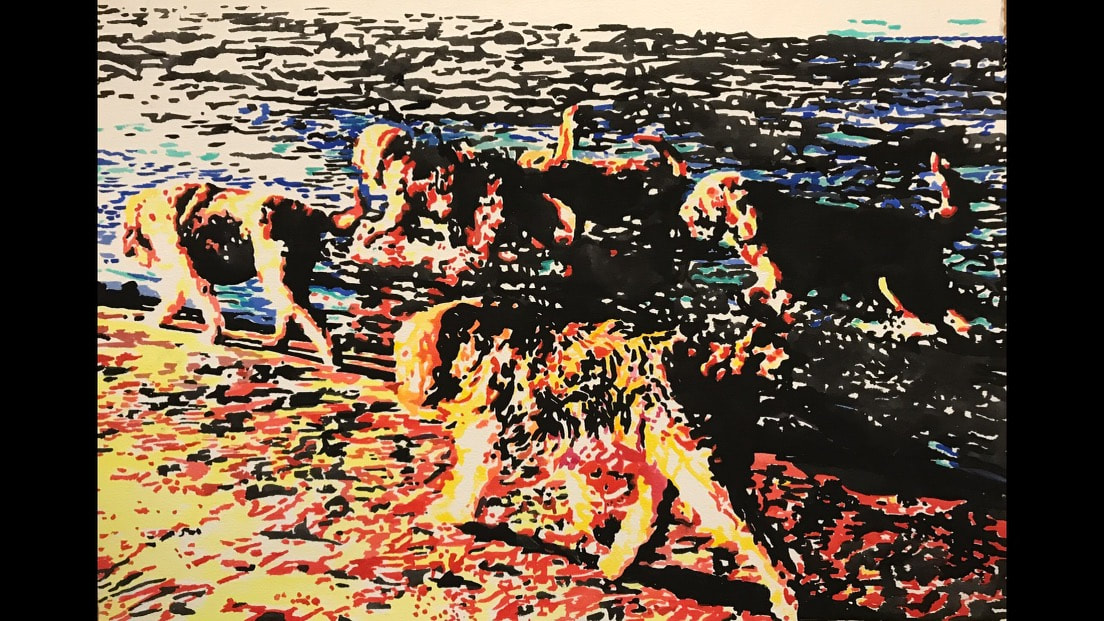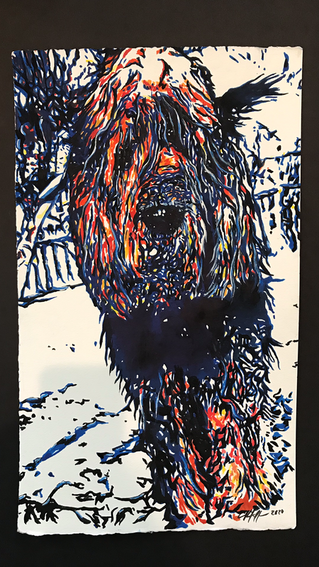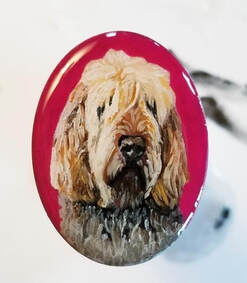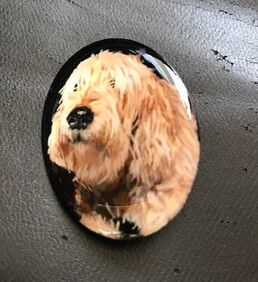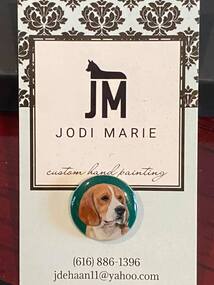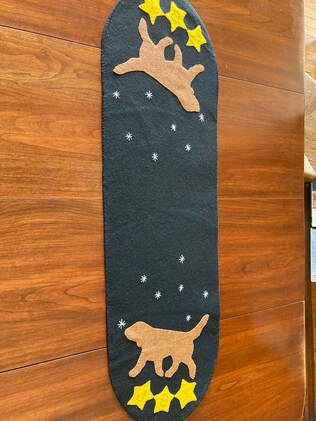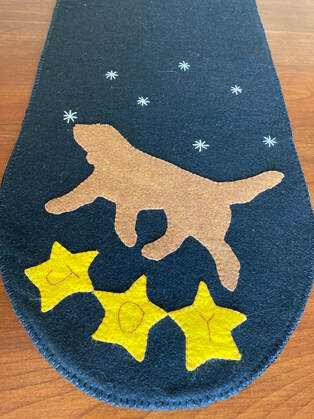Be sure to scroll all the way to the end of this newsletter to see the work of our artists for this year's art raffle!
Words from our President, Joellen Gregory DVM
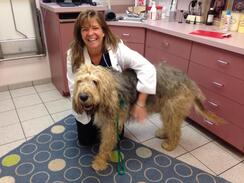
We hope everyone is staying safe and we look forward to when things get back to normal (whatever that “new normal” will look like) after the pandemic. We are excited that many other parent clubs have taken this time to start to form their own Reproduction Bank and we’re proud that the OHCA Reproduction Bank, Inc. is not only the standard that others are using, but we are also helping other breeds preserve their genetics through sharing our processes.
We were disappointed not to see everyone in September at the OHCA National Specialty, but we hope everyone is planning on coming to the OHCA National in September 2021. We are hoping to line up a freezing clinic for anyone who would like to have their dog’s semen frozen and hopefully some of you will donate a collection to the OHCA Reproduction Bank, Inc. Please keep your eyes and ears open for more information.
We were appreciative of those who participated in our Christmas in July sale and hope any gifts you bought (for others or for yourself!) were well received. We are planning for our annual Art Auction this spring – please read on in the Newsletter for more information.
With the current pandemic, some of us have lost loved ones and it’s made me think about future planning. Please remember that we have forms for anyone who would like to include a donation of Otterhound frozen semen in their will. Please contact the Bank if you have questions.
Reproductively yours,
Joellen Gregory DVM
We were disappointed not to see everyone in September at the OHCA National Specialty, but we hope everyone is planning on coming to the OHCA National in September 2021. We are hoping to line up a freezing clinic for anyone who would like to have their dog’s semen frozen and hopefully some of you will donate a collection to the OHCA Reproduction Bank, Inc. Please keep your eyes and ears open for more information.
We were appreciative of those who participated in our Christmas in July sale and hope any gifts you bought (for others or for yourself!) were well received. We are planning for our annual Art Auction this spring – please read on in the Newsletter for more information.
With the current pandemic, some of us have lost loved ones and it’s made me think about future planning. Please remember that we have forms for anyone who would like to include a donation of Otterhound frozen semen in their will. Please contact the Bank if you have questions.
Reproductively yours,
Joellen Gregory DVM
Whether shopping for yourself or your Otterhound please remember to place your order using Amazon Smile to benefit the Otterhound Club of America Reproduction Bank Inc. Just set us as your 501(c)(3) charity and Amazon sends us quarterly donations to help our mission to preserve genetic materials for the future. Click on the link below for more details.
smile.amazon.com/gp/chpf/about/ref=smi_aas_redirect?ie=UTF8&%2AVersion%2A=1&%2Aentries%2A=0
smile.amazon.com/gp/chpf/about/ref=smi_aas_redirect?ie=UTF8&%2AVersion%2A=1&%2Aentries%2A=0
Meet our HandsomeWinter Playboy!
It's Ch. Cheery OH's Return to Scentasia, "Jake".
Details for this handsome hound are available on his page. www.ohca-reprobank.org/jake.html
A new volunteer opportunity
Those of us who have worked with the Repro Bank have found it very rewarding because we are working for a cause that is so important to Otterhounds and their future. The support of OHCA members along with many others has been overwhelmingly gratifying.
We would love help with:
Records Management
The Records Manager will have the responsibility of keeping track and documenting the records of the dogs in the OHCA Reproduction Bank.
This includes:
This includes:
- Making sure the males and females using the bank have a CHIC number, i.e. have been tested for Glanzmann's, have hip x-rays and blood submitted to the University of Missouri, all made public on the Orthopedic Foundation for Animals (OFA) website.
- Keeping track of the semen status of the dogs in the Bank. i.e. whether their semen is ready to be used per the Repro Bank's guidelines.
- Contacting the owners of donor dogs if the tests in #1 have not been completed.
- Keeping the Board updated on the status of the dogs and their semen.
Frozen Semen--Does It Really Work?
by Joellen Gregory DVM
Freezing of animal semen to preserve bloodlines started in 1952 when a champion bull was first frozen. Canine semen was frozen in the 1960s at a university for research. Freezing of canine semen became more common in the 1980s and 1990s. The benefits are that we can use a dog to sire a litter after they are gone, or if their schedule is such that it doesn’t allow for fresh chilled semen shipment, or if the bitch is in an environment where it is difficult to get next-day shipments. The use of frozen semen has allowed us to expand our pedigree searches worldwide looking for that perfect match for our bitch.
However, just because you can freeze it, does it actually work? There are several factors to be aware of when you are considering freezing semen or using frozen semen. Interestingly, one of the NON-factors is whether it is stored in straws or pellets. As long as you have enough semen for the breeding, the method that is used to freeze and store it does not matter.
One of the biggest factors in using frozen semen is what we call the “thaw report”. That tells us how well the semen handled the process of freezing and thawing. The quality of the semen when thawed is very correlated to the quality prior to freezing. If the semen is not of good quality when frozen, it is not likely to be of good quality when thawed. I expect to lose a minimum of 20% motility after thawing. Another factor is how the semen responds to the extender used in the freezing process. Thankfully, there are many extenders available, so if your young dog has good quality semen going into the freeze, but it is not a high-quality thaw report, you should consider trying again with a different extender (you may need to find a different veterinarian to freeze as most of us keep only 1 freezing extender in stock.) I have also learned that with the extender my clinic uses, the speed and temperature that I thaw semen at can make a difference.
Frozen semen is stored in liquid nitrogen. Should a liquid nitrogen tank “fail”, anything stored in that tank will thaw and therefore be destroyed. There are some freezing centers that do not keep the frozen semen at their facility to try to avoid issues like a tank failure, and they store at a central location. The benefit is that the storage tanks at the central location are monitored with alarms to reduce the chance of loss should a tank fail; the downside is that your semen is not available at your freezing center should you want to use it without notice. Many people choose to insure their frozen semen in case of a tank failure – most freezing centers do not carry insurance that covers it.
How it freezes and thaws and keeping it stored correctly are all critical to success when using frozen semen, but the other portion of success is in its use. Frozen semen will live for approximately 12 hours after thawing, in comparison to chilled semen that will live for 2-3 days after insemination and fresh semen that can live for up to a week in the female reproductive tract. The short lifespan of frozen semen necessitates that it be used at the right time (3-4 days after ovulation in the bitch) and that it is deposited directly into the uterus.
There are several methods to timing ovulation in the bitch. The most successful is to use a combination of factors. Following serial progesterone values is the most common method of ovulation timing. What you are looking for is a sharp rise in progesterone. The values of progesterone will depend on both your bitch and on the machine the progesterone is run. Keep in mind that values do NOT correlate across machines and that there are 2 standard measurements for progesterone – it is reported in either ng/ml or nmol/ml. There is a very big difference in the numbers between those systems, so you always should make sure you identify the standard used. The machine that the progesterone value is also very variable. I do not recommend trying to compare values between machines or labs. It is best to stick to one machine for that ovulation’s timing. Each cycle can be very different, so knowing that your bitch ovulated on day 15 on 3 previous cycles does not mean that she will ovulate on day 15 again this time. Hence, you need serial progesterone values so you can see when the sharp rise occurs.
In addition to progesterone testing, many veterinarians also like to follow for the LH (lutenizing hormone) spike. Typically, the LH will peak around 48 hours prior to ovulation starting. If you are going to use LH testing, it is recommend that you have blood drawn daily (every 12 hours is ideal), the blood is centrifuged and the serum is removed and frozen. Once the progesterone starts to increase, the frozen serum is checked starting 2-3 days prior looking for that positive LH spike. LH can spike in less than 24 hours, so if you are not freezing serum every 12 hours, you may not see a fully positive LH, you may see a weak positive two days in a row. As you can imagine, LH testing can be time consuming and difficult.
Two other factors that can be used to follow ovulation are vaginal cytology and how the vaginal vault looks. These are best done by veterinarians that do this regularly – it takes time and experience to learn how things should look at breeding.
Once you have identified ovulation, you will want to put semen into your bitch’s uterus approximately 72-96 hours from ovulation starting. The two most common methods are with a transcervical insemination (TCI) or a surgical insemination. With a TCI, the bitch is awake and standing, a scope is placed into the vaginal vault, a catheter is fed through the cervix, and the semen is deposited into a horn (or the uterine body, depending on how far the catheter is introduced.) There is no recovery time for the bitch. For a surgical insemination, the bitch is placed under general anesthesia, there is an incision made into the ventral abdomen, the uterus is elevated and both horns are inseminated, typically close to the ovaries. The uterus is returned to the abdomen, the abdomen is closed and the bitch has to stay quiet for 2 weeks while her abdominal wall (and skin) heal.
Both methods can be successful with frozen semen. A benefit of TCI is that you can do that multiple times in one cycle, covering a wider time with the short-lived frozen semen. Most veterinarians who do these procedures, however, prefer more semen for a TCI than a surgical breeding. There is a general consensus that we want a minimum of 120 million normal sperm (the importance of that thaw report!) for a surgical breeding in a bitch the size of an average Otterhound, but we would like approximately 200 million normal sperm for (each) TCI. If you have a limited amount of frozen semen, you should discuss with your veterinarian the best course of action for your bitch.
While quality of the semen and timing of the bitch are paramount when using frozen semen, you will also have better success with a younger uterus. Historically, veterinarians recommended that a bitch be “proven” prior to using frozen semen; but with our ability to pinpoint ovulation now, there is no reason the bitch needs to have had a previous litter before using frozen semen. We recommend following your breed’s standards for health testing and breeding.
However, just because you can freeze it, does it actually work? There are several factors to be aware of when you are considering freezing semen or using frozen semen. Interestingly, one of the NON-factors is whether it is stored in straws or pellets. As long as you have enough semen for the breeding, the method that is used to freeze and store it does not matter.
One of the biggest factors in using frozen semen is what we call the “thaw report”. That tells us how well the semen handled the process of freezing and thawing. The quality of the semen when thawed is very correlated to the quality prior to freezing. If the semen is not of good quality when frozen, it is not likely to be of good quality when thawed. I expect to lose a minimum of 20% motility after thawing. Another factor is how the semen responds to the extender used in the freezing process. Thankfully, there are many extenders available, so if your young dog has good quality semen going into the freeze, but it is not a high-quality thaw report, you should consider trying again with a different extender (you may need to find a different veterinarian to freeze as most of us keep only 1 freezing extender in stock.) I have also learned that with the extender my clinic uses, the speed and temperature that I thaw semen at can make a difference.
Frozen semen is stored in liquid nitrogen. Should a liquid nitrogen tank “fail”, anything stored in that tank will thaw and therefore be destroyed. There are some freezing centers that do not keep the frozen semen at their facility to try to avoid issues like a tank failure, and they store at a central location. The benefit is that the storage tanks at the central location are monitored with alarms to reduce the chance of loss should a tank fail; the downside is that your semen is not available at your freezing center should you want to use it without notice. Many people choose to insure their frozen semen in case of a tank failure – most freezing centers do not carry insurance that covers it.
How it freezes and thaws and keeping it stored correctly are all critical to success when using frozen semen, but the other portion of success is in its use. Frozen semen will live for approximately 12 hours after thawing, in comparison to chilled semen that will live for 2-3 days after insemination and fresh semen that can live for up to a week in the female reproductive tract. The short lifespan of frozen semen necessitates that it be used at the right time (3-4 days after ovulation in the bitch) and that it is deposited directly into the uterus.
There are several methods to timing ovulation in the bitch. The most successful is to use a combination of factors. Following serial progesterone values is the most common method of ovulation timing. What you are looking for is a sharp rise in progesterone. The values of progesterone will depend on both your bitch and on the machine the progesterone is run. Keep in mind that values do NOT correlate across machines and that there are 2 standard measurements for progesterone – it is reported in either ng/ml or nmol/ml. There is a very big difference in the numbers between those systems, so you always should make sure you identify the standard used. The machine that the progesterone value is also very variable. I do not recommend trying to compare values between machines or labs. It is best to stick to one machine for that ovulation’s timing. Each cycle can be very different, so knowing that your bitch ovulated on day 15 on 3 previous cycles does not mean that she will ovulate on day 15 again this time. Hence, you need serial progesterone values so you can see when the sharp rise occurs.
In addition to progesterone testing, many veterinarians also like to follow for the LH (lutenizing hormone) spike. Typically, the LH will peak around 48 hours prior to ovulation starting. If you are going to use LH testing, it is recommend that you have blood drawn daily (every 12 hours is ideal), the blood is centrifuged and the serum is removed and frozen. Once the progesterone starts to increase, the frozen serum is checked starting 2-3 days prior looking for that positive LH spike. LH can spike in less than 24 hours, so if you are not freezing serum every 12 hours, you may not see a fully positive LH, you may see a weak positive two days in a row. As you can imagine, LH testing can be time consuming and difficult.
Two other factors that can be used to follow ovulation are vaginal cytology and how the vaginal vault looks. These are best done by veterinarians that do this regularly – it takes time and experience to learn how things should look at breeding.
Once you have identified ovulation, you will want to put semen into your bitch’s uterus approximately 72-96 hours from ovulation starting. The two most common methods are with a transcervical insemination (TCI) or a surgical insemination. With a TCI, the bitch is awake and standing, a scope is placed into the vaginal vault, a catheter is fed through the cervix, and the semen is deposited into a horn (or the uterine body, depending on how far the catheter is introduced.) There is no recovery time for the bitch. For a surgical insemination, the bitch is placed under general anesthesia, there is an incision made into the ventral abdomen, the uterus is elevated and both horns are inseminated, typically close to the ovaries. The uterus is returned to the abdomen, the abdomen is closed and the bitch has to stay quiet for 2 weeks while her abdominal wall (and skin) heal.
Both methods can be successful with frozen semen. A benefit of TCI is that you can do that multiple times in one cycle, covering a wider time with the short-lived frozen semen. Most veterinarians who do these procedures, however, prefer more semen for a TCI than a surgical breeding. There is a general consensus that we want a minimum of 120 million normal sperm (the importance of that thaw report!) for a surgical breeding in a bitch the size of an average Otterhound, but we would like approximately 200 million normal sperm for (each) TCI. If you have a limited amount of frozen semen, you should discuss with your veterinarian the best course of action for your bitch.
While quality of the semen and timing of the bitch are paramount when using frozen semen, you will also have better success with a younger uterus. Historically, veterinarians recommended that a bitch be “proven” prior to using frozen semen; but with our ability to pinpoint ovulation now, there is no reason the bitch needs to have had a previous litter before using frozen semen. We recommend following your breed’s standards for health testing and breeding.
Watch your mailbox for details of our annual unique
Reprobank Art Raffle.
Original art portraits of our beloved Otterhounds are treasures beyond compare. This year's art raffle features Illinois artist Cindy Huffman of Gray House Studio, Springfield, IL. You can see some of her gorgeous and whimsical work below. Cindy makes an effort to understand not only the physical qualities of the dog she paints but also to get a glimpse into their soul. Cindy will need a photo of your pet to work from.
Cindy Huffman, Gray House Studio
Michigan artist, Jodi Geerlings, a repeat performer for this year's auction.
The 2nd place winner will receive a hand-painted custom-made pin or pendant of a pet of their choice done in acrylic by Jodi Geerlings. Jodi will also need clear head shot photos to work from. You can see more of Jodi's work on her Facebook page, "Jodi Marie".
Third prize is a beautiful table runner made by Dr. Michelle Uhl in black wool felt with blanket stitching.
This table runner was made by Dr. Michelle Uhl who wanted to do something to help support the Repro Bank. Michelle is a longtime friend and lover of Otterhounds. The runner is black wool felt with blanket stitching around the edge and has hand sewn felt appliqués of Otterhounds and stars. The yellow stars spell out “JOY”. It measures 39” X 12”.
Ticket prices are: 1 ticket/$10, 3 tickets/$25 and 5 tickets/$40. The drawing will be held by Zoom on Saturday,
May 1, 2021. A Zoom Link will be sent out to friends of the Bank and other interested people. Calls will be made to winners so when you return your ticket stubs, be sure to write on your phone number. You can't win if you don't buy a ticket!
*********************************************************************************************************************
May 1, 2021. A Zoom Link will be sent out to friends of the Bank and other interested people. Calls will be made to winners so when you return your ticket stubs, be sure to write on your phone number. You can't win if you don't buy a ticket!
*********************************************************************************************************************
Ever wonder how the Reprobank uses contributions and money we earn fundraising?
Currently the OHCA Reproduction Bank is storing semen of 15 dogs, mostly at Iowa State University where we pay annual storage fees. When we attend a National Specialty and have an opportunity to collect dogs, we pay for their collection if the owner agrees to have the necessary health testing done. We purchased kits for the Glanzmann's test so we may offer them to donors at a discounted price. We also pay to keep our website online as well as the expenses involved in fundraising. Our board members serve as volunteers and do the legwork to keep our operation functioning with our president veterinarian advising on collection details, writing articles for our website and connecting to the AKC. Our fundraising director handles activity mailings and shipping of merchandise, our secretary handles correspondence, and our vice president shares records as needed and handles meetings if the president is unavailable. Our treasurer handles tax filings, accounting for funds and keeping our website up to date. All board members attend monthly meetings forming policies and activities of this 501(c)(3). All of us greatly appreciate the generosity and support of Otterhound owners across the United States and Canada.
